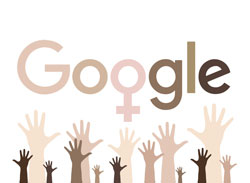Women and minority students, faculty, and other members of the Tech industry shared their reactions to Google’s latest diversity statistics for 2016. Although white men still account for a majority of Google’s workforce, the tech-giant has made slow but steady progress towards their goal of a more inclusive company.
According to the data, 69 percent of Google’s approximately 50,000 employees worldwide were men in 2016. Of its U.S. employees, 59 percent were white, 32 percent were Asian, three percent were Hispanic, and two percent were black.
“Google is not where we want to be when it comes to diversity,” Laszio Bock, Google’s former Senior Vice-president of People Operations, wrote in a blog post. “And it’s hard to address these kinds of challenges if you’re not prepared to discuss them openly, and with the facts.”
Diversity has been a challenge for many other major tech companies, includingApple, Facebook, and Yahoo, who have all reported similar gender and ethnic imbalances in the past.
“There is a stereotype that is often portrayed on TV and movies that the ‘IT Guy’ is some nerdy white guy…that lives in his parent’s basement,” said Aisha Flores, an employee at Azalea Creative, a tech company. “If you look at the persona of many of the Google’s employees they fit the stereotypical attributes.”
Jamie Kretsch, Chair of the Computer Science and Software Engineering Department, said that she has seen a number of instances where students in her department have debunked such stereotypes.
“At last count, at least six Monmouth football players are enrolled in our Computer ScienceandSoftware Engineeringprogram, and they are joined bya large number of female and maleathletesin other sportsranging from track and field to soccer to basketballand beyond,” she said.
According to ncwit.org companies with the highest representation of women in their management teams have a 34 percent higher return on investment than did those with few or no women.
Taylor Campos, a senior computer science student, said, “I’m a woman and I am Hispanic, but I didn’t let my race or gender stop me from entering the field.”
“As a senior, I see younger girls coming into the major, and when I see that they are nervous, I tell them that they will be fine. I think there is a big intimidation factor for girls coming into engineering and computer science majors. I think they look at those majors, and assume that they wouldn’t belong. I have classes where I am literally the only girl, but you just have to stick with it,” Campos continued.
“A company that designs and builds automobiles, plans on selling those vehicles to women as well as men, so it only makes sense that the team designing and building those vehicles has equal representation of women and men to ensure that the vehicles meets the needs of both,” said Kretsch.
Underrepresentation in tech is even greater amongst minorities, even though groups with greater diversity solve complex problems better and faster than do homogenous groups, according to ncwit.org.
To some learned in racial disparities like Manuel Chavez, a lecturer of world languages and cultures, Google’s diversity statistics were unsurprising. He asserts that the underrepresentation of minorities in the tech world can be attributed to the educational obstacles that these groups face.
“At the high school level, Black and Latinx students continue to graduate at a lower rate than White students. Also, Blacks and Latinxs are less likely to hold a bachelor’s degree. Studies have shown that the differences in educational attainments are usually linked to lower school funding and other institutional deficiencies,” said Chavez.
“Given these educational obstacles, the odds are against the possibility for many Blacks and Latinxs to even apply to companies like Google, let alone to makes it through the application process,” Chavez continued.
Flores deduced that more minorities might be inspired towards entering the field if the tech world did more to recognize and highlight the many diverse people already in the field. “There have always been Black, Latino, and female technologists. As we can see from the movie Hidden Figures, we often do not receive recognition for our contributions in the tech space,” she said.
“Highlighting the many innovations created by people of color should be brought to the forefront to show everyone that we exist, and to encourage the next generations that they can also operate in this space,” Flores added.
Chaves deduced that tech companies need to take an academic approach to solving the problem. “Ideally, the leaders of the IT world should educate themselves about the causes for racial inequalities in our society and actively support public policies that seek to transform the social conditions for a more equitable world,” he said.
Darius Jenkins, a senior software engineering student, thinks that tech companies should increase outreach that impacts adolescents. “The way I think there could be more diversity is if the IT world builds programs in high-schools, middle schools, and elementary schools, that teach kids about computers, programming, and learning how to advance themselves in this ever advancing world,” he said.
Abdul-Muhsin Al-Kandari, a graduate software engineering student, agreed with Jenkins assertions. “These companies need to visit elementary and middle schools, and create programs there. If they establish a strong enough base then they can build up,” he said.
“You don’t start with the roof, and go down. Companies like Google keep trying to go from the top downwards, when they should start from the roots.”
IMAGE COMPLIED by Jamilah McMillan




